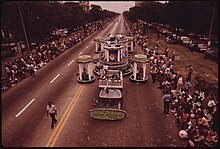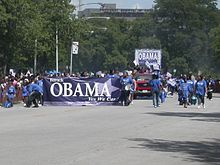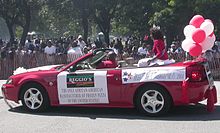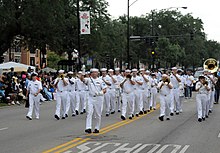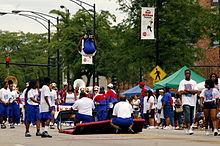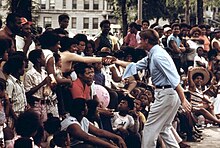Gay Is Not the New Black
It’s hard to deny that homosexual marriage appears to be a foregone conclusion in America. This is a frightening prospect not only for those of us who understand marriage to be a testimony of the relationship between Christ and his bride, the church, but also for all who value the family and its contribution to the well-being of society and human thriving. And while it’s difficult to watch a coordinated, well-funded, well-connected propaganda strategy undermine thousands of years of human history, it’s especially disconcerting to witness the use of the civil rights struggle as the vehicle for the strategy.
The idea that same-sex “marriage” is the next leg in the civil rights race is ubiquitous. One of the clearest examples of the conflation of homosexual “marriage” and civil rights is Michael Gross’s article in The Advocate, in which he coins the now-popular phrase “Gay is the new black.”1 Gross is not alone in his conflation of the two issues, however. At a 2005 banquet, Julian Bond, former head of the NAACP, said, “Sexual disposition parallels race. I was born this way. I have no choice. I wouldn’t change it if I could. Sexuality is unchangeable.”2 Nor is this kind of thinking exclusive to the political left. When asked by GQ magazine if he thought homosexuality was a choice, Michael Steele, former chairman of the Republican National Committee, replied:
Oh, no. I don’t think I’ve ever really subscribed to that view, that you can turn it on and off like a water tap. Um, you know, I think that there’s a whole lot that goes into the makeup of an individual that, uh, you just can’t simply say, oh, like, “Tomorrow morning I’m gonna stop being gay.” It’s like saying, “Tomorrow morning I’m gonna stop being black.”3
Even the California Supreme Court bought in to this line of reasoning. In a February 2008 decision they reasoned:
Furthermore, in contrast to earlier times, our state now recognizes that an individual’s capacity to establish a loving and long-term committed relationship with another person and responsibly to care for and raise children does not depend upon the individual’s sexual orientation, and, more generally, that an individual’s sexual orientation—like a person’s race or gender—does not constitute a legitimate basis upon which to deny or withhold legal rights.4 (emphasis added)
The California Supreme Court, like Gross, would have us believe that the homosexual struggle for a redefinition of marriage puts them in the same category as my ancestors. However, they would rather you didn’t take a closer look, lest you see how flimsy the comparison turns out to be.
Unidentifiable Minority
The first problem with the idea of conflating “sexual orientation” and race is the fact that homosexuality is undetectable apart from self-identification. Determining whether or not a person is black, Native American, or female usually involves no more than visual verification. However, should doubt remain, blood tests, genetics, or a quick trip up the family tree would suffice. Not so with homosexuality. There is no evidence that can confirm or deny a person’s claims regarding sexual orientation.5 Moreover, the homosexual community itself has made this identification even more complicated in an effort to distance itself from those whose same-sex behavior they find undesirable. The Jerry Sandusky case is a prime example. Sandusky is accused of molesting numerous young boys during and after his tenure at Penn State. However, try placing the label “homosexual” on his activities and the backlash will be swift and unequivocal. “Pedophiles are not homosexuals!” is the consistent refrain coming from the homosexual community, media, academia, and the psychological/medical establishment.6 Hence, it seems same-sex attraction alone isn’t enough to identify a person as a homosexual. And what about LUGS7 in college, or same-sex relationships in prison? Are these people homosexual? How about men who are extremely effeminate but prefer women, or those who once were practicing homosexuals but have since come out of the lifestyle (i.e., 1 Cor. 6:9-11)?
In short, it’s impossible to identify who is or is not a homosexual. As a result, how do we know to whom the civil rights in question should be attributed? Should a man who isn’t a homosexual (assuming we could determine such a thing) but tries to enter a same-sex union be treated the same as a woman who isn’t Native American but tries to claim it to win sympathy, or casino rights, or votes? But this isn’t the only problem with the civil rights angle.
Unalterable Definition
An additional problem with the “gay is the new black” argument is the complete disconnect between same-sex “marriage” and anti-miscegenation laws. First, there is a categorical disconnect. Miscegenation literally means “the interbreeding of people considered to be of different racial types.” Ironically, the fact that homosexuals cannot “interbreed” shines a spotlight on the problem inherent in their logic. How can forbidding people who actually have the ability to interbreed be the same thing as acknowledging the fact that two people categorically lack that ability?8
Second, there is a definitional disconnect. The very definition of marriage eliminates the possibility of including same-sex couples. The word marriage has a long and well-recorded history; it means “the union of a man and a woman.” Even in cultures that practice polygamy, the definition involves a man and several women. Therefore, while anti-miscegenation laws denied people a legitimate right, the same cannot be said concerning the denial of marriage to same-sex couples; one cannot be denied a right to something that doesn’t exist. It should be noted that the right to marry is one of the most frequently denied rights we have. People who are already married, 12-year-olds, and people who are too closely related are just a few categories of people routinely and/or categorically denied the right to marry. Hence, the charge that it is wrong to deny any person a “fundamental right” rings hollow. There has always been, and, by necessity, will always be discrimination in marriage laws.
Third, there is a historical disconnect. As early as the time of Moses, recorded history is replete with interracial marriages. In our own history, the marriage of John Rolfe and Pocahontas in the 17th century,9 along with the fact that anti-miscegenation laws were usually limited only to the intermarrying of certain “races” of people (i.e., black and white), stands as historical evidence of the legal and logical inconsistency of such laws. Thus, unlike same-sex “marriage” advocates, those fighting for the right to intermarry in the civil rights era had history on their side.
Fourth, there is a legal disconnect. One thing that seems to escape most people in this debate is the fact that homosexuals have never been denied the right to marry. They simply haven’t had the right to redefine marriage. But don’t take my word for it; listen to the Iowa Supreme Court in their decision in favor of same-sex “marriage”: “It is true the marriage statute does not expressly prohibit gay and lesbian persons from marrying; it does, however, require that if they marry, it must be to someone of the opposite sex.” There it is: not only in black and white, but in a legal decision. Homosexuals haven’t been deprived of any right. How, then, do those on the side of same-sex marriage continue to make the claim that this is a civil rights issue? The key is in the next paragraph:
[The] right of a gay or lesbian person under the marriage statute to enter into a civil marriage only with a person of the opposite sex is no right at all. Under such a law, gay or lesbian individuals cannot simultaneously fulfill their deeply felt need for a committed personal relationship, as influenced by their sexual orientation, and gain the civil status and attendant benefits granted by the statute.
I feel the need to remind the reader that this is a legal decision, since phrases like “gay or lesbian individuals cannot simultaneously fulfill their deeply felt need for a committed personal relationship” tend to sound out of place in such a document. Further, this is asinine logic. For example, following this line of reasoning, one could argue, “I have the right to join the military, but I am a pacifist. Therefore, I don’t really have the right (since it would be repulsive to me). Therefore, we need to establish a pacifist branch of the military so that I can fulfill both my desire to join, and my desire not to fight.” However, this reasoning is critically important in order to make the next leap in logic. “[A] gay or lesbian person can only gain the same rights under the statute as a heterosexual person by negating the very trait that defines gay and lesbian people as a class—their sexual orientation.”
Unsustainable Precedent
Perhaps the most damning aspect of the civil rights argument is logical unsustainability. If sexual orientation/identity is the basis for (1) classification as a minority group, and (2) legal grounds for the redefinition of marriage, then what’s to stop the “bisexual” from fighting for the ability to marry a man and a woman simultaneously since his “orientation” is, by definition, directed toward both sexes?10 What about the member of NAMBLA whose orientation is toward young boys?11 Where do we stop, and on what basis? Homosexual advocates are loath to answer this question. In fact, they are adept at avoiding it (and are rarely pressed on the point). However, the further legal implications of court decisions about same-sex marriage are inevitable. Nowhere is this clearer than in Lawrence v. Texas, a decision that struck down anti-sodomy laws. In the majority decision, Justice Kennedy cited his 1992 opinion in Planned Parenthood v. Casey:
These matters, involving the most intimate and personal choices a person may make in a lifetime, choices central to personal dignity and autonomy, are central to the liberty protected by the Fourteenth Amendment. At the heart of liberty is the right to define one’s own concept of existence, of meaning, of the universe, and of the mystery of human life. Beliefs about these matters could not define the attributes of personhood were they formed under compulsion of the State.12
I have no legal training, and I recognize the limits of my ability to fully evaluate the implications of such a decision. However, I do take notice when Justice Scalia responds to this assertion by stating:
I have never heard of a law that attempted to restrict one’s “right to define” certain concepts; and if the passage calls into question the government’s power to regulate actions based on one’s self-defined “concept of existence, etc.,” it is the passage that ate the rule of law.13 (emphasis added)
Inescapable Confrontation
It is very important for those of us who oppose the idea of same-sex “marriage” to do so not because we wish to preserve our version of the American Dream, but because we view marriage as a living, breathing picture of the relationship between Christ and his church (Eph. 5:22ff), and because we know that God has designed the family in a particular way. While the design of the family promotes human thriving (Gen 1:27-28), the testimony points people to their only hope in this life and the next. As a result, silence on this issue is not an option. Unfortunately (and quite ironically), many Christians have been bullied into silence by the mere threat of censure from the homosexual lobby. “Oppose us and you’re no better than Gov. Wallace, Hitler, and those homophobes who killed Matthew Shepard!” is their not-so-subtle refrain. Consequently, we spend so much time trying to prove we’re not hate-filled murderers that we fail to recognize that the Emperor has no clothes. There is no legal, logical, moral, biblical, or historical reason to support same-sex “marriage.” In fact, there are myriad reasons not to support it. I’ve only provided a few.
Share this: with your friends and family
 De 6:14 Ye shall not go after other gods (Supreme beings), of the gods (Supreme beings) of the people which are round about you;
De 6:14 Ye shall not go after other gods (Supreme beings), of the gods (Supreme beings) of the people which are round about you;






